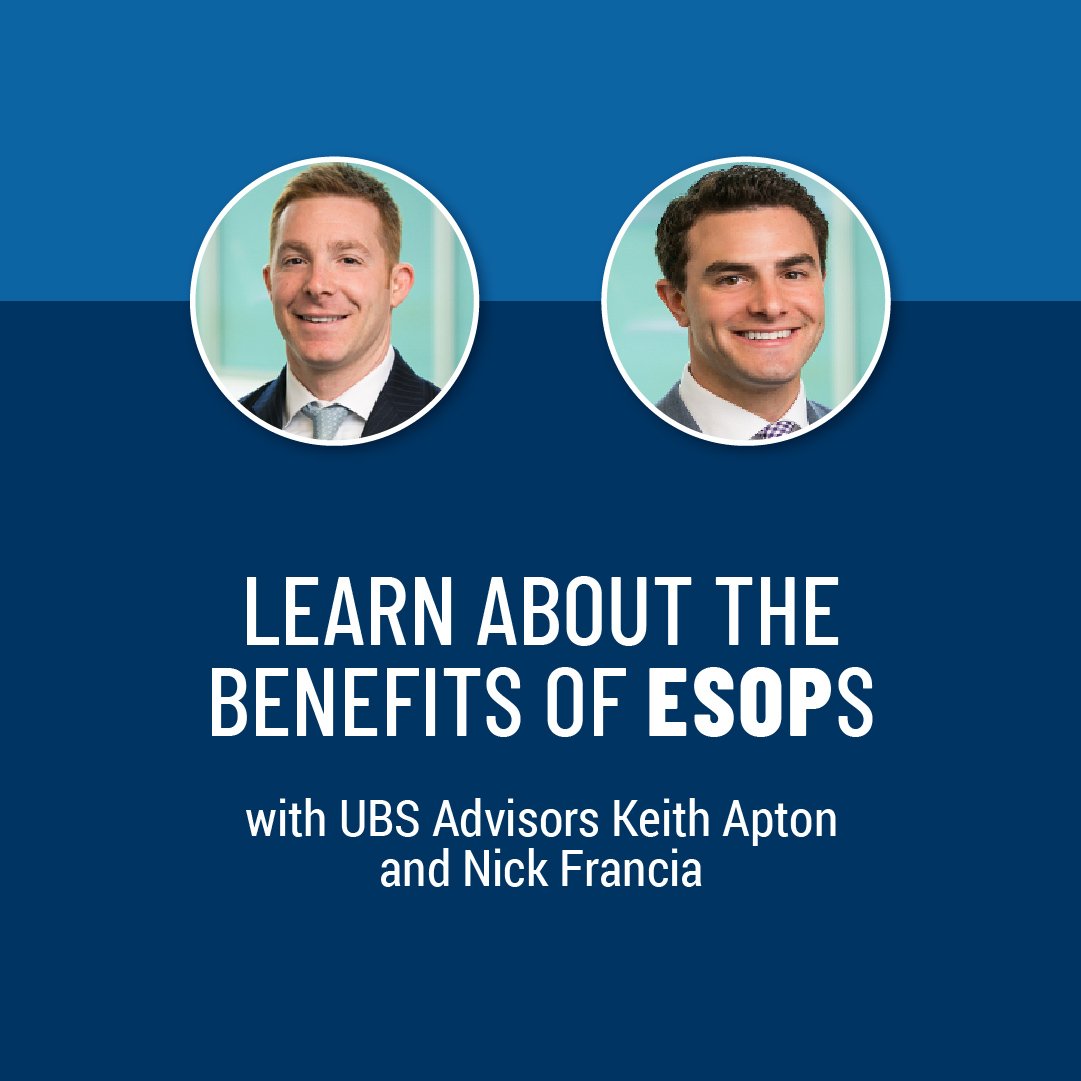
THE EXIT PLANNING BLOG
Keep up-to-date with exit planning, succession planning, industry trends, unique specialty insights, and useful content for professional advisors and business owners.
Share this
Learn about ESOPs from Industry Experts
by Colleen Kowalski on October 12, 2021

As a business owner thinking about exiting your business, you have a vast expanse of exit options to consider. Do you want to sell your business to a third party? Are you planning on transitioning your company to the second or third-generation business owner in your family? Perhaps you are thinking of liquidating the business and all its assets. One option that many owners may have heard of but never considered is an Employee Stock Ownership Plan or ESOP.
October is National Employee Ownership Month, and according to the National Center for Employee Ownership, as of 2021, there are roughly 6,600 employee stock ownership plans covering more than 14 million participants.
What is an Employee Stock Ownership Plan?
So what exactly is an ESOP? According to The ESOP Association, “Employee Stock Ownership Plans (ESOPs) are retirement plans, governed by some of the same laws and regulations as 401(k) plans. ESOPs, though, are fundamentally different from 401(k)s, offering far more advantages to businesses, owners, employees, and communities.”
When ESOPs are formed, shares of company stock are allocated to all employees. This makes them employee-owners who share in the rewards if the stock rises and the risks if the stock falls. As employee-owners with a larger stake in the financial successes of the company, the employees are more invested in creating lasting improvements in the business.
We interviewed Keith Apton and Nick Francia, both Financial Advisors with UBS Global Wealth Management’s Capital ESOP Group, about the rise of ESOPs and how they can benefit both the exiting owner and the employees of the business they’re exiting.
See what they had to say about the benefits of an ESOP below.
What are the Advantages and Disadvantages of an ESOP for Owners?
Advantages:
An ESOP is a flexible and tax-efficient exit strategy for owners of privately-held businesses. Their flexibility comes from the fact that an owner can sell any portion of their stock in the company to the ESOP, from 1% to 100%. A partial sale to an ESOP (selling less than 100% of one’s stock) can allow owners to extract liquidity from the company in the present while retaining a controlling interest and upside potential in the company’s future growth. The option remains to sell more stock to the ESOP in the future, should the owner choose to do so. An ESOP offers flexibility for companies with multiple owners, as well; if one owner wishes to exit or retire, they may do so while the other owners stay on with the company
The tax efficiency of an ESOP transaction creates the potential for more in initial after-tax proceeds compared to other exit strategies, such as selling to an outright buyer or private equity. This is due to the owner’s ability to sell stock and defer or potentially eliminate the capital gains taxes associated with the sale by electing Internal Revenue Code Section 1042.
Additional advantages involved in ESOP transactions include having a “built-in buyer” that can pay fair market value for the company’s stock within a 4-6 month timeline, while other exit strategies may require a search for a suitable strategic buyer who will make a reasonable offer. ESOP transactions can help diversify an owner’s wealth away from their business, and they can be structured to achieve the owners’ individual philanthropic, estate planning, and business succession goals.
Disadvantages:
Every exit strategy has unique advantages and disadvantages. Although an ESOP can provide a flexible, tax-efficient option for business owners, it is also a complex process. The ESOP transaction structure must comply with ERISA regulations, and some level of seller financing is usually required. In a 100% stock sale to an ESOP, it can take 5 to 7 years for the owner to be fully cashed out; this timeline can extend to 10 or more years in a transaction with multiple tranches. As a holder of company debt before being fully paid out, the seller carries some level of business risk. There are expenses and other considerations involved in implementing an ESOP, and it may not be the best option for all business owners.
What are the Advantages and Disadvantages of an ESOP for Employees?
Advantages:
An ESOP can act as a way to reward employees with an additional retirement benefit through contributions of company stock. Employees do not pay for the shares in any manner. Like any other qualified retirement plan, employees do not pay taxes on the shares or any interest income earned in the ESOP account until they begin receiving distributions. Once fully vested, an employee may sell the shares of company stock in their ESOP account back to the company at market value if they choose to exit the company. An ESOP can be used in addition to any other traditional retirement plans, such as a 401(k), that the company may have in place.
In addition to creating a costless retirement benefit for employees, an ESOP can provide significantly higher returns than other, traditional retirement plans studies. In 2013, the National Center for Employee Ownership (NCEO) released a study showing that ESOP participants had 2.5 times the amount of retirement assets compared to comparable non-ESOP companies. Additionally, the total returns per participant of private S Corporation ESOP company shares were shown to outperform the S&P 500 index by over 60%.
ESOPs can also help create job stability and security for employees. According to the NCEO, companies with ESOPs are 50% less likely to experience bankruptcy and 40% less likely to go out of business than non-ESOP companies. Studies have also found an improvement in company culture and higher median incomes in ESOP-owned companies.
Disadvantages:
There is a vesting schedule for the shares contributed to employees’ ESOP accounts. While all shares must be fully vested within six years, the employees generally must wait between 3 and 6 years to be fully vested in their shares.
What are the Tax Benefits for an Exiting Owner with an ESOP?
If the privately-held business is a C corporation at the time of sale, the selling shareholder may be able to defer or potentially eliminate capital gains taxes on their proceeds from the stock sale. Under Section 1042 of the Internal Revenue Code (“Code Section 1042”), the seller can defer taxes on the ESOP sale proceeds provided that the ESOP owns at least 30% of the company’s outstanding stock after the sale and the selling shareholder invests an amount equal to their sale proceeds into securities designated as Qualified Replacement Property within 12 months of the transaction closing.
If the business is an S corporation, it will enjoy company level-tax advantages as an ESOP-owned company. It will be exempt from federal income taxes (and often state income taxes) to the extent of ESOP ownership; for example, if the ESOP owns 49% of the company’s outstanding stock, then 49% of the company’s profits will not be subject to income taxes.
In some cases, an S corporation will convert to C corporation status immediately before an owner sells stock to the ESOP so that the owner can enjoy the tax advantages of a Code Section 1042 election. The company must then wait for the required five taxable periods before converting back to S corporation status, at which point it can enjoy the company-level tax benefits of being an ESOP-owned S corporation.
Under What Conditions Would You Recommend an Owner Consider an ESOP?
- If the owner would like to sell part of his/her company but would like to retain ownership.
- If the owner(s) would like to sell stock in their company in a tax-efficient manner.
- If a company has multiple owners and one or some wish to retire, while the others have the opportunity to remain active in the business.
- If the owner(s) believe the business is strong and will continue to perform well into the future during the life of the ESOP.
- If the owner wishes to extract liquidity in the present and diversify part of their wealth away from the business but may not wish to retire or relinquish control of the company.
- If the owner has philanthropic, estate planning, business succession or other personal goals where a stock sale to an ESOP can be beneficial.
An owner should consider the following questions when considering an ESOP transaction:
- Is the company profitable?
- Does the company have a minimum of 30 employees?
- Does this company have an annual payroll of at least $1 million?
- Does the company have moderate to significant debt capacity?
- Did the company have strong earnings and/or cash flows over the previous two years?
- Is the company experiencing steady and controlled growth?
- Does the company benefit from significant corporate income tax savings?
- Does the company currently make contributions to an employee benefit plan?
- Would the current executive team be incentivized by equity-based compensation?
- Would the selling shareholders like to participate in the future growth of the company after the sale?
How Does the Business Valuation Process Differ in an ESOP?
An ESOP is classified as a financial buyer, very much like private equity. By definition, an ESOP cannot pay a strategic premium or more than fair market value for a company’s stock, but ESOP deal sizes are typically competitive with offers from private equity or outright buyers. Enterprise value calculations for ESOP transactions are typically the same as in other types of transactions; however, the main difference is the 5% marketability discount, which can be much higher (15% to 30%) in a non-ESOP context.
What are the Traditional Reasons a Business Owner Decides to Use an ESOP Instead of Selling to a Third Party?
There are several reasons why a business owner would prefer to sell to an ESOP rather than to a third party. Owners who wish to retain some level of ownership in their company often choose to do a partial ESOP transaction. Companies with multiple shareholders may choose to use an ESOP to provide flexibility for one or some of the owners to exit and extract liquidity while allowing the other owners to remain in control of and/or active in the management of the company. In some cases, multiple owners who are looking to sell their company may not be able to agree on the terms for a transaction; these owners may look to an ESOP to create their own transaction structure that will meet each of the owners’ individual goals.
Are you interested in learning more about ESOPs, exit options, and the basics of value creation? Attend one of the upcoming Certified Exit Planning Advisor (CEPA) credentialing programs.
Download our CEPA Brochure today!
Learn More About CEPAThe Capital ESOP Group
UBS Financial Services Inc.
1501 K St. NW
Washington, DC 20005
Neither UBS Financial Services Inc. nor any of its employees provide tax or legal advice. You should consult with your personal tax or legal advisor regarding your personal circumstances.
As a firm providing wealth management services to clients, UBS Financial Services Inc. offers investment advisory services in its capacity as an SEC-registered investment adviser and brokerage services in its capacity as an SEC-registered broker-dealer. Investment advisory services and brokerage services are separate and distinct, differ in material ways and are governed by different laws and separate arrangements. It is important that clients understand the ways in which we conduct business, that they carefully read the agreements and disclosures that we provide to them about the products or services we offer. For more information, please review the PDF document at ubs.com/relationshipsummary.
UBS Financial Services Inc. is a subsidiary of UBS AG. Member FINRA. Member SIPC.
Share this
- Blog (547)
- CEPA (426)
- exit planning (249)
- CEPA community (188)
- Business Owner (172)
- Exit Planning Summit (97)
- EPI Chapter Network (89)
- Value Acceleration Methodology (80)
- Exit Planning Partner Network (76)
- EPI Announcement (49)
- Content (48)
- Webinars (37)
- Excellence in Exit Planning Awards (33)
- Marketing (30)
- 2024 Exit Planning Summit (28)
- 5 Stages of Value Maturity (26)
- Books (24)
- EPI Academy (24)
- EPI Team (22)
- Exit Planning Teams (22)
- Leadership (21)
- 2023 Exit Planning Summit (20)
- family business (20)
- women in business (19)
- Intangible Capital (18)
- Exit Options (17)
- Black Friday (16)
- CPA (15)
- Walking to Destiny (15)
- State of Owner Readiness (14)
- Chapters (13)
- Chris Snider (12)
- National Accounts (12)
- Small business (12)
- charitable intent (12)
- personal planning (12)
- Financial Advisors (11)
- Season of Deals (9)
- 5 Ds (8)
- About us (8)
- Podcast (8)
- Insiders Bash (7)
- Scott Snider (7)
- Christmas (6)
- Exit Planning Content Library (6)
- Case Studies (5)
- Owner Roundtables (5)
- Three Legs of the Stool (5)
- Value Advisors (5)
- financial planning (5)
- Awards (4)
- Circle of Excellence (4)
- Exit & Succession (4)
- Five Ds (4)
- executive training (4)
- EPI Thought Leadership Council (3)
- Owners Forum (3)
- author (3)
- forbes (3)
- DriveValue (2)
- Exit Is Now Podcast (2)
- Peter Christman (2)
- Veteran (2)
- Whitepapers (2)
- Business Owners Forum (1)
- SOOR (1)
- business consultants (1)






